IES (Indian Economics Service) - [General Economics Paper - I (Section A) Question - 1 (a) 2022]
Show that the ordinary demand curve will have a greater demand elasticity than the compensated demand curve.
The ordinary demand curve shows the relationship between the quantity demanded of a good or service and its price, holding all other factors constant. The compensated demand curve, on the other hand, shows the relationship between the quantity demanded and the price, holding all other factors constant and taking into account the effect of any changes in income or substitution effects on the demand for the good or service.
Demand elasticity refers to the degree to which the quantity demanded of a good or service responds to a change in its price. A demand curve is considered elastic if a small change in price results in a relatively large change in the quantity demanded, and inelastic if a large change in price is required to produce a small change in the quantity demanded.
The ordinary demand curve will have a greater demand elasticity than the compensated demand curve because the ordinary demand curve only considers the direct relationship between price and quantity demanded, while the compensated demand curve takes into account the indirect effects of changes in income and substitution on the demand for the good or service. This means that the compensated demand curve will be less sensitive to changes in price compared to the ordinary demand curve.
For example, consider a consumer who is considering purchasing a good or service that is a necessity (such as food or medical care). If the price of the good or service increases, the consumer may still need to purchase it due to their necessity, even if the price is relatively high. In this case, the ordinary demand curve for the good or service would be relatively inelastic, as a large increase in price would be required to reduce the quantity demanded. However, the compensated demand curve for the good or service would be more elastic, as the consumer would have the option to substitute the good or service with other necessities or change their consumption patterns in response to the change in price.
Thanks for your time ( Have A Great Week :)
. . .
"Let them hate you all they want" - Lesson of the Week
.gif)







.png)

.png)

.gif)
.png)
0 Comments